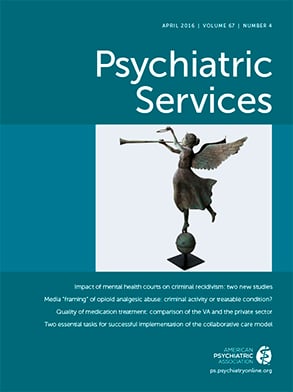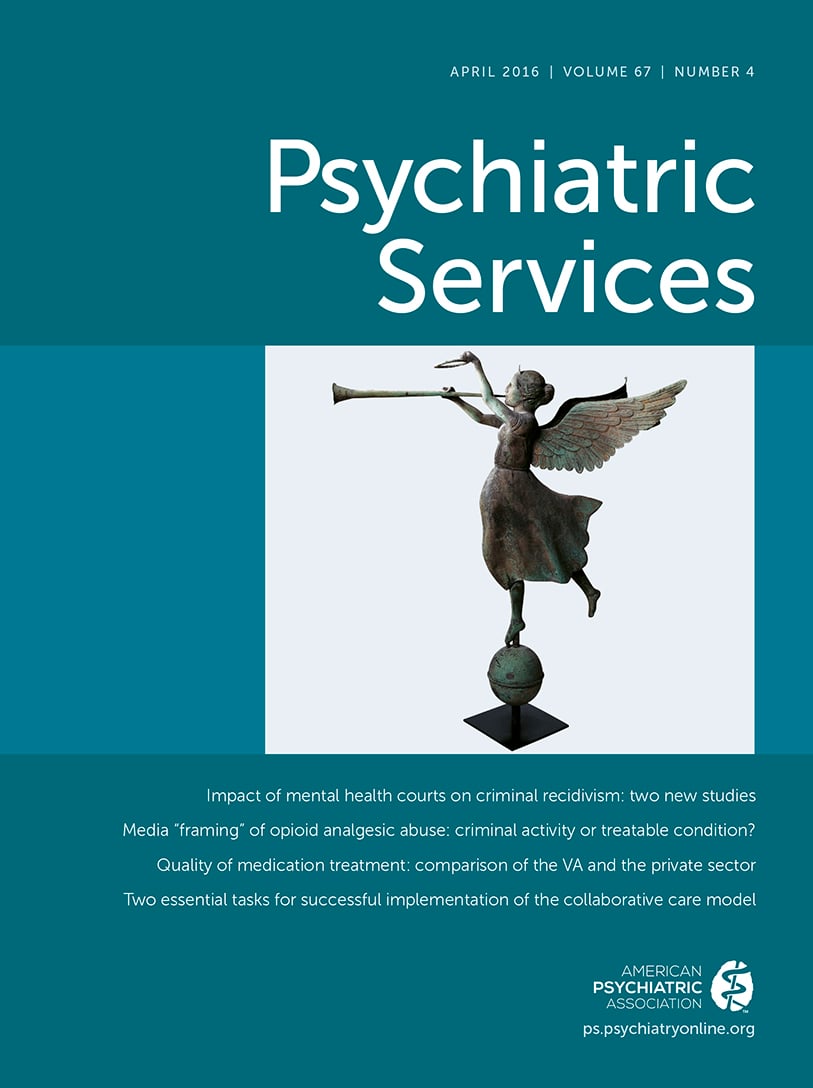Anita Everett voted APA president-elect: Members of the American Psychiatric Association (APA) have elected Anita Everett, M.D., as APA’s next president-elect. Dr. Everett is division director of Johns Hopkins Community and General Psychiatry, Bayview Campus, and a faculty member at the Johns Hopkins School of Medicine and the Bloomberg School of Public Health at Johns Hopkins in Baltimore. She is currently president of the American Association of Community Psychiatrists and a past president of the Maryland Psychiatric Society. Dr. Everett will officially become president-elect on May 18 at the close of this year's APA annual meeting in Atlanta, at which time the current president-elect, Maria Oquendo, M.D., will succeed Renée Binder, M.D., as president.
APA’s position statement on involuntary outpatient commitment: The APA’s Board of Trustees approved a position statement that directs the organization’s ongoing advocacy efforts on involuntary outpatient commitment (IOC), also known as assisted outpatient treatment. The document sets out standards for these court-mandated treatment programs, which are aimed at patients with severe mental illness and documented histories of poor compliance leading to repeated relapses and rehospitalizations. APA’s position is that IOC can be effective when “systematically implemented, linked to intensive outpatient services, and prescribed for extended periods of time” (an initial commitment period of 180 days, with extensions possible after judicial review). The document acknowledges the controversy surrounding IOC: “Involuntary outpatient treatment raises an ethical tension between the principles of autonomy and beneficence. Therefore states should make every effort to dedicate resources to voluntary outpatient treatment and only if such treatment fails resort to involuntary treatment.” The position statement was developed by a work group led by Marvin Swartz, M.D., under the auspices of APA’s Council on Psychiatry and Law in consultation with the Committee on Ethics. The statement is accompanied by an 18-page resource document, which provides information to policy makers and others who are developing or implementing legislation related to IOC. The resource document presents key conclusions and recommendations, reviews empirical findings, and addresses critical issues, such as criteria for IOC, length of treatment, response to nonadherence, use of involuntary medication, and potential racial disparities. The position statement and resource document are available on the APA Web site (
www.psychiatry.org/home/policy-finder).
APA offers free training in collaborative care: As part of a $2.9 million, four-year Transforming Clinical Practice Initiative grant from the Centers for Medicare and Medicaid Services, APA has begun to offer training in the principles and practice of collaborative care, a specific model of integrated care developed by the late Wayne Katon, M.D., Jürgen Unützer, M.D., M.P.H., and colleagues at the AIMS (Advancing Integrated Mental Health Solutions) Center at the University of Washington in Seattle. The first levels of that training are being offered at APA’s 2016 annual meeting in May and in October at the Institute on Psychiatric Services. A free two-part course, encompassing seven online learning modules, is also available on the APA Web site (
education.psychiatry.org). The online course was developed by the AIMS Center as an initiative of the APA Board Work Group on Health Care Reform. The training is designed for psychiatrists who plan to participate on a collaborative care team or who want to incorporate principles of the model into their current practice. Participants can earn six category 1 CME credits.
Report focuses on caregivers of adults with mental illness: The National Alliance for Caregiving, in partnership with Mental Health America and the National Alliance on Mental Illness, has released a study of the current status of caregivers of adults with mental illness. At least 8.4 million Americans are providing care to an adult with moderate to serious mental health problems, according to the report,
On Pins & Needles: Caregivers of Adults With Mental Illness, which presents findings from online interviews conducted in September 2015 with 1,601 caregivers. Four in ten caregivers interviewed reported that they had struggled to find an accurate diagnosis for their family member, and caregivers of adults who had an accurate diagnosis reported that it took 12 years, on average, to obtain one. The caregivers reported an average of 32 hours of care per week, and they had been providing care for an average of nine years. The 48-page document makes several recommendations based on extensive data gathered in the online interviews, which documented a lack of access to adequate services, difficulties navigating the health care system, and problems with parity coverage of mental health care. The report is available on the Web site of the National Alliance for Caregiving (
www.caregiving.org/mentalhealth).
Minnesota study documents $1B cost savings for health homes: A University of Minnesota evaluation of health care homes has found that over five years (2010–2014) the model saved Medicaid and Medicare approximately $1 billion. At the same time, clinics participating in a health care home model of care outperformed other clinics on quality measures. These findings are from an evaluation of health care homes funded by the Minnesota Department of Health (MDH). The health care home program, an effort to transform primary care, is a cornerstone of a health reform initiative implemented in Minnesota in 2008. In a health care home, primary care providers, families, and patients partner to improve health outcomes and quality of life for patients, including those with chronic conditions or disabilities. Currently, MDH has certified 361 clinics—54% of all primary care clinics in Minnesota—as health homes, and about 3.6 million individuals receive care in certified clinics. The evaluation analyzed Medicare and Medicaid claims data, comparing the use and cost of services between certified health home clinics and noncertified clinics. Medical costs for patients of health home clinics were 9% less—12% less for Medicaid enrollees, 3% less for “dual eligibles,” and cost neutral for Medicare enrollees. Costs were lower in four spending categories: inpatient admissions, hospital outpatient visits, skilled nursing facilities, and pharmacy. The 224-page report,
Evaluation of the State of Minnesota’s Health Care Homes Initiative: Evaluation Report for Years 2010–2014, is available on the University of Minnesota Web site (
www.health.umn.edu/sites/default/files/UM%202015%20HCH%20Evaluation%20Final%2007Feb2016.pdf).
Urban Institute brief focuses on SSDI eligibility and effects of other programs: The Social Security Disability Insurance (SSDI) program provides benefits to nearly 11 million persons with disabilities and their families. In 2013, SSDI beneficiaries received an average monthly benefit of $1,146—about $2,300 more per year than the federal poverty guideline for a family of one. Many SSDI beneficiaries are eligible for multiple other programs, such as Supplemental Security Income (SSI), Temporary Assistance for Needy Families, unemployment insurance, workers’ compensation, state and local disability benefits, and Department of Veterans Affairs benefits, and for new health insurance options and subsidies under the Affordable Care Act. SSDI benefits are generally reduced if the beneficiary earns more than a threshold called the “substantial gainful activity amount,” which was $1,090 per month in 2015 ($1,820 for blind beneficiaries). Changes in benefit amounts received through other programs can have ramifications for SSDI eligibility and benefits. A new brief from the Urban Institute describes these ramifications, in particular how receipt of other benefits can affect an individual’s decision about whether and when to apply for SSDI. The report also describes long-term fiscal challenges faced by the SSDI and SSI programs. The seven-page report,
Understanding Social Security Disability Insurance: Interactions With Other Programs, is available on the Urban Institute Web site (
www.urban.org/research/publication/understanding-social-security-disability-insurance-interactions-other-programs).
NASHP guide for state policy makers on blending funding streams: A new guide from the National Academy for State Health Policy poses answers to a question that state policy makers might ask: “What would it take for an entity to fund a total person-centered plan of health services and supports for a Medicaid beneficiary?” According to the guide, answers would entail braiding and blending funds to pay for general medical and behavioral health care, stable housing in a safe neighborhood, nutritious food and warm clothing, transportation, child care, and a case manager with the authority to arrange and pay for those services. Determining how to fund such a total plan is important for states because many social determinants of health—stable housing in safe neighborhoods, with access to healthy food—cannot be provided with Medicaid funds. The guide describes differences between blending and braiding funds and illustrates these approaches through the case of a single mother with uncontrolled diabetes, substance abuse, and depression who works part-time at a low-wage job. The 20-page report,
Braiding and Blending Funding Streams to Meet the Health-Related Social Needs of Low-Income Persons: Considerations for State Health Policymakers, is available on the NASHP Web site (
www.nashp.org/braiding-and-blending-funding-streams-to-meet-the-health-related-social-needs-of-low-income-persons-considerations-for-state-health-policymakers/).
NIDA releases five-year strategic plan: The National Institute on Drug Abuse (NIDA) has released its strategic plan for 2016–2020. The plan is designed to increase the understanding of the basic science of the brain as it relates to behavior and translate what is learned into more effective prevention and treatment interventions to reduce the negative impacts of drug use and substance use disorders. NIDA plans to focus on four high-level strategic goals centered on basic science, prevention, treatment, and public health: identify the biological, environmental, behavioral, and social causes and consequences of drug use and addiction across the life span; develop improved strategies to prevent drug use and its consequences; develop new and improved treatments to help people with substance use disorders achieve and maintain a meaningful and sustained recovery; increase the public health impact of NIDA research and programs. NIDA will prioritize science relevant to pressing health challenges, such as the prescription opioid and heroin overdose epidemic, the slow adoption of evidence-based prevention and treatment interventions, the flood of new synthetic drugs of abuse, and the spread of HIV resulting from drug use. The
2016–2020 NIDA Strategic Plan is available on the NIDA Web site (
www.drugabuse.gov/about-nida/2016-2020-nida-strategic-plan).
HUD and HHS announce demonstration providing up to five years of housing for youths: The Department of Housing and Urban Development (HUD) and the Department of Health and Human Services (HHS) have announced an opportunity for child welfare directors and local public housing agencies to work together to provide young people with housing and service supports. The demonstration, which extends the time that housing and services can be offered to young people from 18 months to five years, provides child welfare and housing agencies the opportunity to develop and strengthen partnerships and strategies to prevent and end homelessness among youths who have exited foster care and who lack the necessary resources and supports to maintain stable housing. Requests to participate in the demonstration are due by July 15, 2016. More information is available on the Web site of the United States Interagency Council on Homelessness (
www.usich.gov/news/new-demonstration-for-youth-provides-up-to-five-years-of-housing-FSS).

